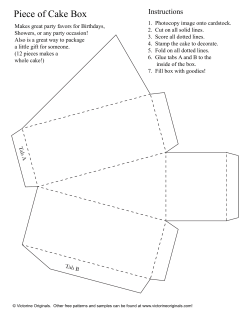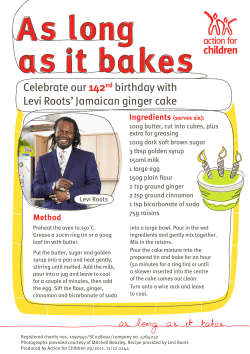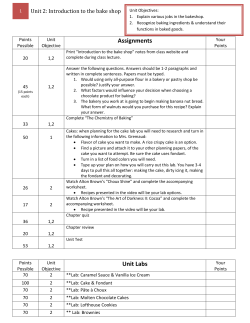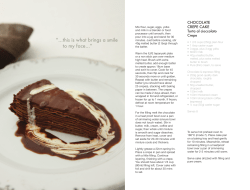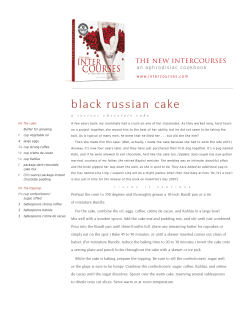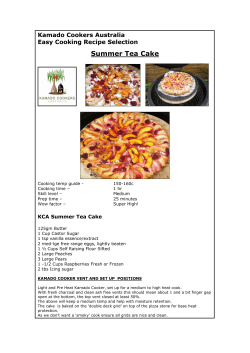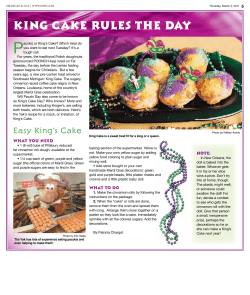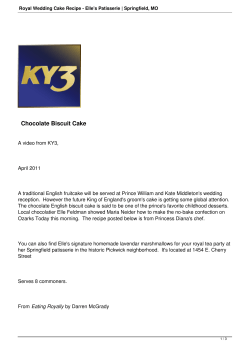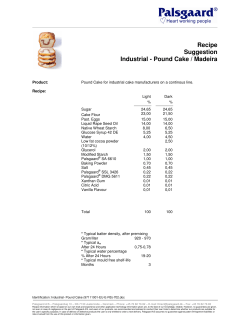
Effect of banana peel cellulose as a dietary fiber supplement... sensory qualities of butter cake
Songklanakarin J. Sci. Technol. 35 (6), 641-646, Nov. - Dec. 2013 http://www.sjst.psu.ac.th Original Article Effect of banana peel cellulose as a dietary fiber supplement on baking and sensory qualities of butter cake Chiraporn Sodchit, Worasit Tochampa, Teeraporn Kongbangkerd, and Riantong Singanusong1* Department of Agro-Industry, Faculty of Agriculture, Natural Resources and Environment, Naresuan University, Phitsanulok, Mueang, 65000 Thailand. Received 20 January 2013; Accepted 11 August 2013 Abstract Banana peels are a waste product of the banana industry that have caused an environmental problem. Conversion of banana peels to a food ingredient might be an alternative way of value-adding to this waste. This study aimed to extract cellulose from banana peels and use it as an ingredient in butter cake to increase dietary fiber content and to improve cake quality. The selection and optimization of extraction conditions of cellulose from banana peels employed chemical extractions. Banana peel cellulose (BPC) was added to butter cake at 3 levels; 1.5, 3.0 and 4.5% w/w of flour compared with 3.0% commercial cellulose (CC) and the control (no cellulose added). The sensory, chemical, physical and microbiological properties of the butter cakes were then determined. The odor, tenderness and moistness acceptance scores of the butter cake by 50 panelists ranged from “like moderately” to “like very much”, indicating that addition of BPC improved the sensory quality of the cake. The butter cake with added CC and BPC had significantly higher (pd”0.05) moisture and fiber contents than those of the control. Microorganism levels found in the butter cake conformed to the butter cake standard (OTOP standard product of Thailand 459/2549). The optimum concentration of added BPC was 1.5%. Thus, the addition of BPC extracted from banana peels to butter cake increased the fiber content and improve the cake quality. Keywords: banana peel, cellulose, banana peel cellulose, butter cake 1. Introduction Thailand produces large quantities of banana, especially in Phitsanulok province. From the OTOP (One Tumbon (subdistrict) One Product) factories, there are a lot of banana peels, which lead to environmental problems such as bad odor and source of disease. One way of reducing the problem is to find a way to turn the banana peels into a valuable product, namely cellulose, that can be more extensively used in the food industry. Cellulose, the major structural component of plants, is a glucose polymer bonded in the b-1,4 linkage configuration. It can be purified for use as a food ingredient (Ang and * Corresponding author. Email address: riantongs@nu.ac.th Miller, 1989; Prosky and De Vries, 1995). It is probably the least soluble of all fiber components, being insoluble not only in cold or hot water, but also in hot dilute acids and alkalis as well (Prosky and De Vries, 1995). It is not biodegradable and does not provide energy. Therefore, if eaten, it is excreted as waste. It increases the fecal waste in the digestive tract and reduces the risk of colon cancer (Prosky and De Vries, 1995). Addition of cellulose powder increased the viscosity of the liquid mixture of flour due to its insolubility in water, and resulted in a mixture with a high ratio of solid to volume causing friction within the liquid. This caused a stronger gas holding structure since the air bubble membrane was stronger. This meant air bubbles did not combine into a large bubbles and float to the surface of the liquid, resulting in a product with fine air bubbles, more foam volume and better stability (Ang and Miller, 1989; Ang, 1991; Prakongpan et al., 2002; Kamel and Stauffer, 1993). Ang and Miller (1989) added 642 C. Sodchit et al. / Songklanakarin J. Sci. Technol. 35 (6), 641-646, 2013 cellulose powder to cake and measured the texture of the cake using an Instron (Texture) analyzer. They found that cake with low levels of cellulose had a harder texture than that with a high level because the long fibers contributed to a soft cake. Addition of 2-4% cellulose powder improved the texture of the cake, which affected the shelf life, appearance and moisture loss from surface cracking (Jackson and Roufs, 1989; Ang, 1991; Kamel and Stauffer, 1993; Prakongpan et al., 2002). Wongsonsarim et al. (2001) reported the use of cellulose powder as a bulking agent in many foods such as meat products, salads, drink products and especially baked and cereal products, because it did not provide energy and had good ability to absorb water. It could be used to replace fat in low fat bakery products and did not affect the properties of the product. As consumers become more conscious of the need to increase their fiber intake, the demand for healthy, flavorsome and high-fiber food increases. Many researchers have successfully studied methods of increasing fiber content in baked foods by addition of supplements from grain byproducts (Chaudhary and Weber, 1990; Newman et al., 1990; Rasco et al., 1990; Hudson et al., 1992; Rasco and Dong, 1992; Sekhon et al., 1997; Liu et al., 2011), rice straw (Chareonsinsab et al., 2005), corncob (Pongnari, 2004) and pineapple core (Prakonpan et al., 2002). The objective of this study was to extract cellulose from banana peels and use it in the production of butter cake, thus, increasing dietary fiber content and improving the quality of the cake. 2. Materials and Methods 2.1 Sample preparation and extraction of cellulose from banana peels The banana peel cellulose (BPC) was finally obtained (Singanusong et al., 2010). 2.2 Application of BPC as dietary supplement in the butter cake BPC and Commercial Cellulose (CC; cotton linters or cellulose powder, medium fibers produced by Sigma-Aldrich Co., USA) were added to the butter cake and compared with the control with no BPC or CC-added. BPC was used to replace some of the wheat flour in the recipes of butter cake at 3 levels (Table 1) and the properties and quality of the butter cake were determined and compared with the control and those with 3% CC. 2.2.1 Chemical properties of BPC and CC BPC with water activity of 0.47 had moisture, total lipid, protein, carbohydrate, ash, fiber and cellulose contents of 5.16, 2.57, 1.65, 52.56, 4.04, 33.57 and 75.96%, respectively while CC with water activity of 0.11 had 2.25, 0.66, 0.26, 24.44, 0.03, 72.36 and 98.89% respectively (Singanusong et al., 2010). 2.2.2 Physical properties of BPC and CC BPC had an L* value (Hunter Lab, Model DP-900), pH, water holding capacity (WHC) and oil holding capacity (OHC) content of 84.66, 6.05, 2.91 g water/g dried sample and 0.08 g water/g dried sample, while CC had 98.61, 4.92, 1.93 g water/g dried sample and 3.17 g water/g dried sample (Singanusong et al., 2010). 2.3 Preparation of the butter cake Fresh peels from banana (Musa sapientum Linn.) cv. Mali-Ong of maturity stage 7 (yellow peel and a little brown spots (Silayoi, 2002)) which contained carbohydrate (56.35%), followed by fiber (15.30%), ash (56.35%), fat (4.34%), protein (3.74%), moisture content (7.65%) and cellulose content (75.90%) were purchased from the market in Phitsanulok province and immediately cut into 0.3×2.5 cm. in size and dried at 55°C for 10 h using a hot air convection oven. After cooling to room temperature, the material was weighed, ground and passed through a 35 mesh sieve before keeping in a plastic bag and placed in the refrigerator at 4°C. Twenty grams of banana peel powder was mixed with 200 ml of 90% ethanol at the ratio of 1:10 (w/v) in a water bath at 50°C with shaking speed of 150 rpm for 16 h. Then it was washed 3 times with distilled water and filtered with Whatman paper No.4. The defatted banana peel powder was soaked in sodium hydroxide (1:10 w/v) at pH 12 for 24 h. The experiment was conducted in a water bath at 50°C with shaking speed of 150 rpm. The defatted and protein removed banana peel powder was soaked in hydrogen peroxide solutions of 15% for 3 h. The bleached samples were washed 3 times, filtered with Whatman paper No. 4 and dried at 60°C for 10 h. The butter cakes were produced based on the method of Chareonsinsab et al. (2005) and the formulae are presented in Table 1. Wheat flour in the formulation was replaced with 0 (control), 1.5, 3.0, 4.5% BPC and 3.0% CC. The production of butter cake is summarized as follows. Fresh butter was beaten until it rose, the sugar was then added, the beating was continued until the butter turned white, then yolk, egg-white, some of the baking powder, milk and vanilla were added. Finally, lime juice and the rest of the baking powder were added and the mixture was further beaten for 5 min. The batter was transferred into 6-cm inside-diameter greased cake cups and baked at 150°C for 25 min in an oven. The baked cakes were cooled at ambient temperature for 30 min and then packed in plastic bags with a zip lock and kept for further analysis. All analyses were conducted in duplicate. 2.4 Sensory evaluation Butter cakes with 0, 1.5, 3.0, 4.5% BPC and 3.0% CC were tasted by 50 untrained panelists and assessed on a 9 point hedonic scale where 1 was “dislike extremely” and 9 was 643 C. Sodchit et al. / Songklanakarin J. Sci. Technol. 35 (6), 641-646, 2013 “like extremely”. Immediately before sensory testing, butter cakes were sliced into 2.5 cm thick slices and 3×3 cm2 cake pieces were prepared. 2.5 Properties of the butter cake The butter cake was analyzed for the following proper- 2.5.3 Microbial properties The microorganism levels were analyzed according to the OTOP butter cake standard (OTOP Standard Product of Thailand, 2006) using the method of Downes and Ito (2001). 2.6 Statistical analysis ties: 2.5.1 Chemical composition Protein, moisture, total lipid, ash and fiber contents (AOAC, 1995) and also carbohydrate (by calculation). The experimental design for the butter cake production was a completely randomized design (CRD) and the design for sensory evaluation was a randomized complete block design (RCBD). The data were statistically analyzed using ANOVA, and differences in means were analyzed using Duncan’s New Multiple Range Test (p<0.05). 2.5.2 Physical properties 3. Results and Discussion Baking quality was determined by measuring viscosity of the batter, cake volume and cake firmness 1 h after baking. Batter viscosity was measured by a Brookfield Viscometer® (model RVDV P). Cake volume was determined by AACC cake measuring template (AACC, 2000). Cake firmness was measured with an Instron Universal Testing Machine (Model 4411). 3.1 Application of BPC in the butter cake The prepared BPC was substituted for wheat flour in the formula of the butter cake at 1.5, 3.0 and 4.5% (w/w). The properties of the butter cake with BPC-added were compared to those with 3% CC-added and the control (Table 1). Table 1. Formulation of butter cakes. Type of cellulose Ingredients (g) Wheat flour BPC CC Egg yolk Egg white White sugar Butter Vanilla Milk Baking powder Lime 0 1.50% BPC 3.00% BPC 4.50% BPC 3.00% CC 100.00 37.50 37.50 87.50 56.25 2.75 41.25 1.28 2.32 98.50 1.50 37.5 37.5 87.5 56.25 2.75 41.25 1.28 2.32 97.00 3.00 37.50 37.50 87.50 56.25 2.75 41.25 1.28 2.32 95.50 4.50 37.50 37.50 87.50 56.25 2.75 41.25 1.28 2.32 97.00 3.00 37.50 37.50 87.50 56.25 2.75 41.25 1.28 2.32 1.5% BPC 3.0% BPC 4.5% BPC ab ab 7.01±1.20ab 7.43±0.93a 7.33±1.15ab 7.14±1.20ab Table 2. Sensory evaluation of BPC and CC-added butter cake. Acceptance scores Attributes Control Color Odor Tenderness Moistness 3.0% CC b 6.62±1.07 6.43±1.16b 6.24±0.77c 6.33±0.97c a 7.57±1.21 7.10±1.09a 6.81±0.98b 6.52±0.98bc 7.24±1.18 7.29±1.06a 7.57±1.16a 7.52±0.87a 7.19±0.98 7.33±0.86a 7.43±0.87ab 7.10±1.48ab Means with same superscripts in the same row are not significantly different (p>0.05) by Duncan’s multiple range test 644 C. Sodchit et al. / Songklanakarin J. Sci. Technol. 35 (6), 641-646, 2013 The CC-added butter cake had significantly higher positive color scores than those of the control (p<0.05) (Table 2). The color scores of the 1.5, 3.0 and 4.5% BPC-added butter cake were not significantly different from those of the control (p>0.05). The odor score of the BPC-added butter cake was significantly higher than that of the control (p<0.05). The tenderness and moistness scores of the butter cake with 1.5% BPC-added was significantly higher than those with CCadded and the control (p<0.05). The odor, tenderness and moistness scores of the butter cake with BPC-added were significantly higher (p<0.05) than those of the control. The color, odor, tenderness and moistness scores between butter cake with BPC-added at 1.5, 3.0 and 4.5% were not significantly different (p>0.05) (Table 2). The results indicated that the addition of BPC and CC improved the cake quality, mainly the color, odor, tenderness and moistness attributes. Butter cake with 1.5% BPC added had an acceptance scores of 7 for all attributes which was higher than that of the butter cake with 3.0% corncob cellulose-added for which the acceptance score was 6 (Pongnori, 2004). However, the results from this study were similar to the 5.0% rice straw cellulose-added butter cake, which had the acceptance score of 7 (Chareonsinsab et al., 2005). protein, carbohydrate and ash contents. The butter cakes with BPC- and CC-added had higher fiber contents than those of the control (p<0.05) (Table 3). This was due mainly to the addition of BPC and CC in the butter cake. 3.2.2 Physical properties: The butter cakes with BPC- and CC-added had significantly higher volume than that of the control (p<0.05). This was consistent with the results of McConnell et al. (1974); Mary et al. (1977); Ranhotra and Gelroth (1988) and Ang and Miller (1989). It is due mainly to the insolubility of cellulose in water and the high WHC of cellulose, which gives the mixture a high ratio of solid to volume causing friction within the liquid. This caused a better gas holding structure since the air bubble membrane was stronger so that air bubbles did not combine into large air bubbles and float to the surface of the liquid, resulting in product with fine air bubbles and more foam volume with better stability (Mcconnell et al., 1974; Ang and Miller, 1989). The BPC-added butter cake had significantly higher firmness than that of the CC-added and the control (p<0.05) (Table 4). Figure 1 shows butter cake with 1.5% BPC-added which had more regular and even air bubbles than the other butter cakes. 3.2 Properties of the butter cake 3.2.3 Microbial properties: 3.2.1 Chemical composition: The control, BPC- and CC-added butter cakes were not significantly different (p>0.05) in moisture, total lipid, The butter cake was analyzed for standard plate count, Staphylococcus aureus, Bacillus cereus, and yeasts and molds counts (Table 5). All microorganisms found in the Table 3. Chemical composition of BPC and CC-added butter cake. Content (%) Chemical composition (%) Moisture Total lipid Protein Carbohydrate Ash Fiber Control 1.5% BPC 3.0% CC 20.49±1.07a 18.54±1.29a 6.11±1.16a 52.99±0.47a 1.04±0.14ab 0.83±0.41b 20.75±1.18a 17.85±1.21a 6.05±1.12a 52.77±0.54a 0.97±0.09b 1.61±0.76a 20.67±1.21a 18.79±1.18a 5.98±1.07a 51.67±0.61a 1.35±0.17a 1.59±0.52a Means with same superscripts in the same row are not significantly different (p>0.05) by Duncan’s multiple range test Table 4. Physical properties of the BPC and CC-added butter cake. Physical properties Viscosity (cps.) Firmness (kgf) Volume (cm3) Control 1.5% BPC 3.0% CC 36,875±71.53c 1.54±1.16a 2.08 ±1.18b 38,972±71.06b 1.57±1.06a 2.42±1.09a 47,628±83.01a 1.36 ±1.09b 2. 47±1.19a Means with same superscripts in the same row are not significantly different (p>0.05) by Duncan’s multiple range test C. Sodchit et al. / Songklanakarin J. Sci. Technol. 35 (6), 641-646, 2013 645 Figure 1. Butter cake with BPC, CC-added, and the control. Table 5. Microbial properties of the BPC and CC-added butter cake. Microbial count (cfu/g) Type of microorganism Standard plate count Staphylococcus aureus Bacillus cereus Yeasts and molds Control 1.5% BPC 3.0% CC 1.26 103 < 102 < 102 < 102 1.21 103 < 102 < 102 < 102 1.22 103 < 102 < 102 < 102 butter cake conformed to the butter cake standard (OTOP Standard Product of Thailand, 2006). 4. Conclusion The 1.5, 3.0 and 4.5% BPC-added butter cakes had similar odor, tenderness and moistness properties. The butter cakes with CC and BPC- added had overall acceptance of “like moderately” and had higher moisture and fiber contents, volume and viscosity than those of the control. The butter cake with 1.5% BPC-added had more regular and even air bubbles than the other butter cakes. Therefore, the addition of 1.5% BPC was found to be the optimum level for improving the fiber content and quality of the butter cake. Acknowledgements The authors would like to express their sincere thanks to the Office of the National Council of Thailand (NRCT) for financial support. We thank Professor Michael Barbetti for comments on the manuscript. References AACC. 2000. Baking quality of flours, and use of layer cake measuring template. In American Association of Cereal Chemists Official Methods, 9th ed., method 1090, The Association, Saint Paul, Minnesota, U.S.A., pp. 91. Ang, J. F. 1991. Water retention capacity and viscosity effect of powdered cellulose. Journal of Food Science. 56(2), 1682-1684. Ang, J. F. and Miller, W. B. 1989. Enhancement of cake volume by a new form of powdered cellulose. Abstract AACC Annual Meeting. 74(3), 162. Association of Analytical Communities. 1995. Official methods of Analysis of AOAC International, 16th ed., Arlington, Virginia, U.S.A. Charoensinsab, M., Limrungruengrat, K., Mondecha, P. and Saengnark, A. 2005. Effect of particle sizes on functional properties of cellulose powder from rice straw. Thaksin University Journal. 8(1), 47-59. 646 C. Sodchit et al. / Songklanakarin J. Sci. Technol. 35 (6), 641-646, 2013 Chaudhary, V. K. and Weber, F. E. 1990. Dietary fiber ingredients obtained by processing brewer’s dried grain. Journal of Food Science. 55(2), 551-553. Downes, F. P. and Ito, K. 2001. Compendium of Methods for the Microbiological Examination of Food, 4th ed., American Public Health Association, Washington, D.C., U.S.A. Hudson, C. A., Chiu, M. M., and Knuckles, B. E. 1992. Development and characteristics of high-fiber muffins with oat bran, rice bran or barley fiber fractions. Cereal Foods World. 37(5), 373–376. Jackson, G. M. and Roufs, J. G. 1989. Dry mix for microwave layer cake. US Patent 4,857,353, General Mills, Inc., Minneapolis, U.S.A. Kamel, B. S. and Stauffer, C. E. 1993. Advances in Baking Technology. 1st ed., VCH Publisher, New York, U.S.A. Liu, S. X., Singh, M. and Inglett, G. 2011. Effect of incorporation of distillers’ dried grain with soluble (DDGS) on quality of corn bread. LWT–Food Science and Technology. 44, 713–718. Mary, E., Melissa, A. M. and Kukoro, B. W. 1977. Dietary fiber sources for bakery products. Journal of Food Science. 42(6), 1428-1431. McConnell, A. A., Eastwood, M. A. and Mitchell, W. D. 1974. Physical characteristics of vegetable foodstuffs that could influence bowel function. Journal of the Science of Food and Agriculture. 25(12), 1457-1464. Newman, R. K., McGurie, C. F. and Newman, C. W. 1990. Composition and muffin-baking characteristics of flours from four barley cultivars. Cereal Foods World. 35(6), 563–566. OTOP Standard Product of Thailand. 2006. Community standards: cake. OTOP standard product of Thailand 459/2549. Bangkok: Office of Industrial Standards. http://app.tisi.go.th/otop/standard/standards.html [July 1, 2013] Pongnori, J. 2004. The extraction of cellulose from corncob and its application in food. Bangkok, Thailand: Naresuan University, MSc. thesis. (In Thai) Prakongpan, T. Nitithamyong, A. and Luanpituksa, P. 2002. Extraction and application of dietary fiber and cellulose from pineapple cores. Journal of Food Science 67(4), 1308-1313. Prosky, L. and De Vries, J. W. 1995. Controlling dietary fiber in food products. Van Nostrand Reinhold, editor. New York, U.S.A. Ranhotra, G. and Gelroth, J. 1988. Soluble and insoluble fiber in soda crackers. Cereal Chemistry. 65(2), 159-160. Rasco, B. A., Gazzaz, S. S. and Dong, F. M. 1990. Iron, calcium, zinc and phytic acid of yeast-raised breads containing distillers’ grains and other fiber ingredients. Journal of Food Composition and Analysis. 3(1), 88–95. Rasco, B. M. and Dong, F. M. 1992. Baking and storage stability properties of high fiber breads containing comparable levels of different fiber ingredients. Journal of Food Processing and Preservation. 15(6), 433–442. Sekhon, K. S., Dhillon, S. S., Sing, N. and Sing, B. 1997. Functional stability of commercially milled rice bran in India for use in different products. Plant Foods for Human Nutrition. 50(2), 127–140. Silayoi, B. 2002. Bananas. 3rd edition Kasetsart University Press, Bangkok, 357 p. Singanusong, R., Weeragul, K. and Sodchit, C. 2010. Extraction and bleaching of cellulose from banana peels. Proceeding of the International Conference on Food Safety and Security under Changing Climate, Parkroyal Hotel, Penang, Malaysia. December 6-7, 2010. Wongsonsarim, C., Kowattanakul, T. and Donyasak, B. 2001. Using cellulose powder from soybean shell and greenbean shell in deep-fried doughstick. Bangkok, Thailand: Chulalongkorn University, Special problems. (In Thai)
© Copyright 2025
